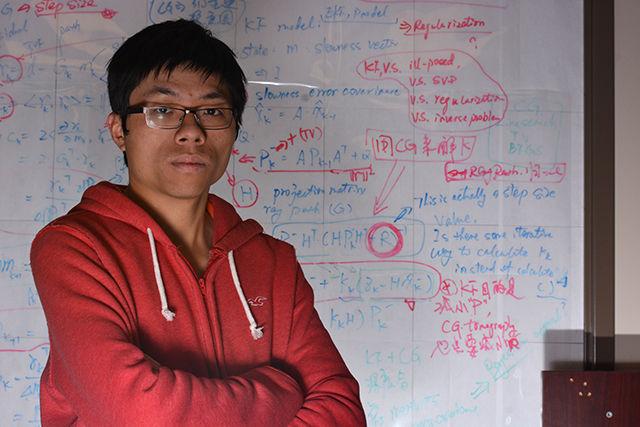 " />
" />
Caide Wooten
Chen Shen, a Ph.D. student studying mechanical engineering, is the lead author of "Anisotropic Complementary Acoustic Metamaterial for Canceling out Aberrating Layers." Shen and assistant professor Yun Jing have designed new complementary metamaterials that can be used to offset the acoustic distortion that usually occurs when attempting to ultrasound through solid materials such as bone.
NC State researchers have developed a new technique that would allow ultrasounds to penetrate bone or metal, which could have implications for medical professionals hoping to use ultrasounds for diagnostic or therapeutic purposes such as treating brain tumors or monitoring blood flow to the brain.
Tarry Shen, a Ph.D. student and the lead author of a paper on this project, and Yun Jing, an assistant professor of mechanical and aerospace engineering and senior author of the paper, have designed the technique that uses metamaterials with aluminum membranes to cancel out the distortion caused by the bones, allowing the ultrasound to see past bones as if they don’t exist.
Ultrasounds emit high frequency acoustic waves that bounce off objects and return the wave to the ultrasound equipment. The equipment, in turn, creates an image from the translated waves.
However, bone and metal have characteristics that block ultrasound waves. These materials are called aberrating layers, and the technique developed by NC State’s researches takes these layers into account and works to offset them.
“Think of this design as a -1 and the skull is a +1,” Jing said. “They would cancel each other out.”
This technique addresses the problem that the acoustic waves from an ultrasound have to be able to reach the affected area without being scattered and reflected by the bones in the body.
“Theoretically, you can focus ultrasounds to treat brain tumors without having to open the skull,” Shen said.
Before this research, it was difficult to use ultrasounds for clinical treatment on brain tumors due to the fact that when the ultrasound waves hit the skull, they would reflect back before reaching the brain, weakening its efficiency.
“The same way light bounces off an object, sound bounces off the skull,” Jing said.
This new ultrasound technique has the potential to improve the transmission of ultrasound through the body so that it can be used in non-destructive surgery, such as cutting off tumors or killing cancer cells.
The technique has the potential to reduce the risk of surgery for cancer patients and eliminate the recovery time, suffering and pain that comes with major surgery. Because ultrasounds use only sound waves, the treatment would not have as many side effects as other cancer treatments.
“With Tarry’s research, we can have 90 percent acoustic wave propagate through the bone and other tissues before the target which may make clinical experiments possible,” said Dingjie Suo, one of Jing’s graduate students.
Using this new technique would also help with ultrasound imaging, which uses high frequency sound waves to look inside the body and help with diagnosis, monitor blood flow and see the body’s internal organs.
Not only is it useful in the field of medicine, but the fact this new technique allows ultrasounds to penetrate through metal has the potential to help find cracks in the wings of airplanes.
“Usually you would have to take off the surface of the plane to find the location of the cracks, which would be expensive,” Yun said.
Allowing these ultrasounds to pass through metal would make finding these faults in the plane much easier, potentially saving lives, according to Yun.
Shen said the research took about one year to complete up to its current point, and there is still more work to be done before the technique is ready to be implemented for professional use.
“There is still more to go, but we have the concept,” Shen said.